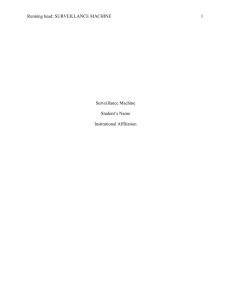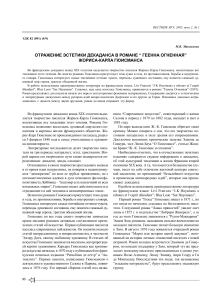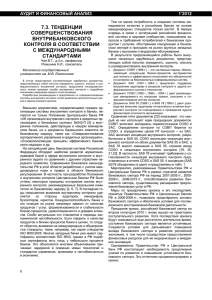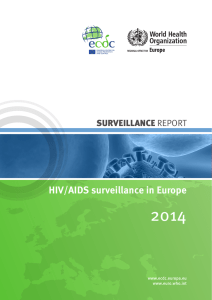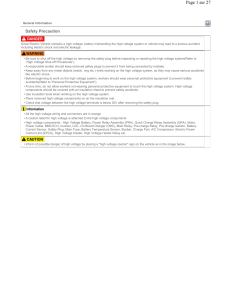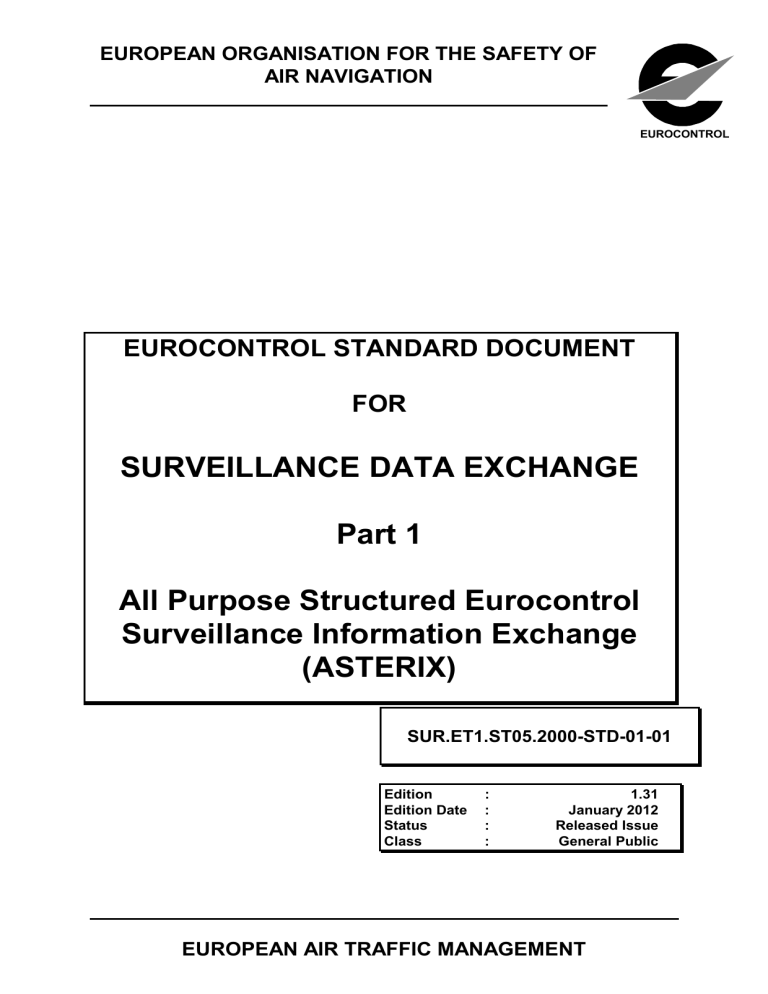
EUROPEAN ORGANISATION FOR THE SAFETY OF AIR NAVIGATION EUROCONTROL EUROCONTROL STANDARD DOCUMENT FOR SURVEILLANCE DATA EXCHANGE Part 1 All Purpose Structured Eurocontrol Surveillance Information Exchange (ASTERIX) SUR.ET1.ST05.2000-STD-01-01 Edition Edition Date Status Class : : : : 1.31 January 2012 Released Issue General Public EUROPEAN AIR TRAFFIC MANAGEMENT DOCUMENT IDENTIFICATION SHEET DOCUMENT DESCRIPTION Document Title Surveillance Data Exchange - Part 1 All Purpose Structured Eurocontrol Surveillance Information Exchange (ASTERIX) PROGRAMME REFERENCE INDEX SUR.ET1.ST05.2000-STD-01-01 EDITION : 1.31 EDITION DATE : January 2012 Abstract This document presents the general structure of the ASTERIX format. Data Exchange Data Category ASTERIX CONTACT PERSON : Keywords SAC Data Block Messages Data Field UAP D. Doukas SIC Data Item TEL : +32-2-729 3460 UNIT : DNM/COO/DCO/SRS DOCUMENT STATUS AND TYPE STATUS Working Draft Draft Proposed Issue Released Issue CATEGORY Executive Task Specialist Task Lower Layer Task CLASSIFICATION General Public EATMP Restricted ELECTRONIC BACKUP INTERNAL REFERENCE NAME : ASTERIX - Part 1 HOST SYSTEM MEDIA Microsoft Windows Type : Hard disk Media Identification : SOFTWARE(S) Surveillance Data Exchange - Part 1 All Purpose Structured Eurocontrol Surveillance Information Exchange (ASTERIX) SUR.ET1.ST05.2000-STD-01-01 DOCUMENT APPROVAL The following table identifies all management authorities who have successively approved the present issue of this document. AUTHORITY NAME AND SIGNATURE DATE ASTERIX Manager D. Doukas SES Unit Manager P. Green SURT Chairman DSS Director Edition : 1.31 L. Tytgat Released Issue Page 1 Surveillance Data Exchange - Part 1 All Purpose Structured Eurocontrol Surveillance Information Exchange (ASTERIX) SUR.ET1.ST05.2000-STD-01-01 DOCUMENT CHANGE RECORD The following table records the complete history of the successive editions of the present document. EDITION DATE Released Ed 1.0 Working Draft Ed 1.1 Draft Ed 1.2 November 1997 August 1998 Adoption by the Eurocontrol Permanent Commission Suppress RFS, units, add migration policy and compound data item structure. October 1998 • Where applicable the term Radar replaced by Surveillance • Introduction amended (1) • X.121 reference suppressed. (2) • Documents referenced in paragraph 2.2 updated (2.2) • Definitions, acronyms and abbreviations updated.(3) • Characteristics of the data suppressed.(4) • Data item symbolic reference changed.(4) • UAP unique per Category as a rule.(4) • Source Identification must be present in every record.(4) • Explicit Length data fields suppressed.(4) • Conventions updated to be more general.(5) • Annex A redesigned and changed to informative. (A) • Annex B replaced by list of SACs affected to USA, Canada & Mexico. (B) • Annex C suppressed. (C) Draft Ed 1.21 January 1999 Draft Ed 1.22 Proposed Ed 1.24 Proposed Ed 1.26 Working Draft Ed 1.27 March 1999 Working Draft Ed 1.28 Working Draft Ed 1.29 Page 2 REASON FOR CHANGE • • • • • 1.1 reworded Explicit Length data fields re-introduced. (4) Reserved Expansion field added. (4) Migration Policy reworded. (7) Editorial corrections SECTIONS PAGES AFFECTED ALL ALL ALL • Editorial corrections SAC added for UK and for Ukraine Annex A updated Editorial correction List of SAC removed Annex A updated Annex B removed Editorial corrections Annex A removed 6.4 A 4.1.1.5 6.4.1 A B December 2001 • • • • • • • • February 2002 • • Note on Reserved Expansion field added Editorial corrections 4.2.6.4 4.2.7.4 September 1999 November 2000 November 2001 Released Issue ALL A Edition : 1.31 Surveillance Data Exchange - Part 1 All Purpose Structured Eurocontrol Surveillance Information Exchange (ASTERIX) Released Issue Ed 1.30 Released Issue Ed 1.31 Edition : 1.31 November 2007 January 2012 • • • • • • SUR.ET1.ST05.2000-STD-01-01 Document ID-sheet updated Signature Page updated Status: Released Issue Document ID-sheet updated Signature Page updated Compatibility policy updated Released Issue 7.2.3 Page 3 Surveillance Data Exchange - Part 1 All Purpose Structured Eurocontrol Surveillance Information Exchange (ASTERIX) SUR.ET1.ST05.2000-STD-01-01 TABLE OF CONTENTS DOCUMENT IDENTIFICATION SHEET.................................................................................ii DOCUMENT APPROVAL .....................................................................................................iii DOCUMENT CHANGE RECORD .........................................................................................iv 1. INTRODUCTION .............................................................................................6 1.1 General .......................................................................................................................6 1.2 Scope..........................................................................................................................7 2. REFERENCES ................................................................................................8 2.1 General ......................................................................................................................8 2.2 Reference Documents ...............................................................................................8 3. DEFINITIONS, ACRONYMS AND ABBREVIATIONS.....................................9 3.1 Definitions ..................................................................................................................9 3.2 Acronyms and Abbreviations .................................................................................10 4. 4.1 DESCRIPTION AND PRINCIPLES OF ASTERIX ........................................11 Organisation of the Data ........................................................................................11 4.1.1 Data Categories ....................................................................................................11 4.1.2 Data Items and Catalogue of Data Items ..............................................................13 4.1.3 Data Fields............................................................................................................13 4.1.4 User Application Profile .........................................................................................13 4.2 The General Message Structure .............................................................................14 4.2.1 General .................................................................................................................14 4.2.2 The Data Block ......................................................................................................14 4.2.3 The Record ...........................................................................................................16 4.2.4 Standard Data Field Formats ................................................................................16 4.2.5 Non-Standard Data Fields.....................................................................................19 4.2.6 Reserved Expansion Data Field .............................................................................19 4.2.7 Field Organisation ..................................................................................................20 5. CONVENTIONS ...........................................................................................23 5.1 Bit Numbering.........................................................................................................23 5.2 Binary Values ..........................................................................................................23 5.3 Time Management ..................................................................................................23 Page 4 Released Issue Edition : 1.31 Surveillance Data Exchange - Part 1 All Purpose Structured Eurocontrol Surveillance Information Exchange (ASTERIX) 6. SUR.ET1.ST05.2000-STD-01-01 ASTERIX ADDRESSING SCHEME...............................................................24 6.1 General .....................................................................................................................24 6.2 Syntax.......................................................................................................................24 6.3 Formats ....................................................................................................................24 6.3.1 System Area Code (SAC) .....................................................................................24 6.3.2 System Identification Code (SIC) ...........................................................................24 6.4 Assignment of the Systems Identifiers ..................................................................25 6.4.1 System Area Codes ...............................................................................................25 6.4.2 System Identification Codes..................................................................................25 7. ASTERIX MIGRATION POLICY....................................................................26 7.1 General .....................................................................................................................26 7.2 Description...............................................................................................................26 7.2.1 Application Domain ................................................................................................26 7.2.2 Version Management .............................................................................................26 7.2.3 Modifications ..........................................................................................................28 Edition : 1.31 Released Issue Page 5 Surveillance Data Exchange - Part 1 All Purpose Structured Eurocontrol Surveillance Information Exchange (ASTERIX) 1. 1.1 SUR.ET1.ST05.2000-STD-01-01 INTRODUCTION General The present Eurocontrol Standard describes the message structure, known by the acronym ASTERIX, standing for All Purpose STructured Eurocontrol Radar Information EXchange, devised by the Study Group on the exchange of surveillance related data between processors of ATC systems. This group was a subgroup of the former Radar Systems Specialist Panel (RSSP), whose responsibilities have been taken over by the Surveillance Team (SURT) as from April 1994. ASTERIX was approved by the former RSSP at their 15th Meeting held on 1/4 July 1986. The ASTERIX standard is now under the responsibility of the Surveillance Task Force for Radar Data Exchange (STFRDE). The expansion of the application domains of ASTERIX led to a modification of the significance of the acronym ASTERIX, now standing for All Purpose STructured Eurocontrol SuRveillance Information EXchange. Page 6 Released Issue Edition : 1.31 Surveillance Data Exchange - Part 1 All Purpose Structured Eurocontrol Surveillance Information Exchange (ASTERIX) SUR.ET1.ST05.2000-STD-01-01 1.2 Scope 1.2.1 ASTERIX is an application/presentation protocol responsible for data definition and data assembly developed to support surveillance data transmission and exchanges. Its purpose is to allow a meaningful transfer of information between two application entities using a mutually agreed representation of the data to be exchanged. 1.2.2 The ASTERIX Standard refers to the Presentation and Application layers (layers six and seven) as defined by the Open Systems Interconnection (OSI) Reference Model (International Standards Organization (ISO) Standard 7498) [Ref. 1]. 1.2.3 The definition of the lower telecommunication support layers (layers one to five) is out of the scope of the ASTERIX Standard. Transmission of ASTERIX coded surveillance information can make use of any available communication medium, for instance a packet switched Wide Area Network (WAN) as well as a Local Area Network (LAN). 1.2.4 The lower telecommunication protocol levels will be agreed between the partners of the data exchange. 1.2. 5 In order to ease the exchange of data between different systems (e.g. potential network interconnection) it is advisable to apply standard telecommunication protocols (e.g. X.25 for WANs) [Ref. 2] simultaneously with ASTERIX. 1.2.6 The ASTERIX Standard, as a Presentation protocol, defines the structure of the data to be exchanged over the communication medium, from the encoding of every bit of information up to the organisation of the data within a block of data. 1.2.7 Considering that there is information common to all systems (for instance position, Mode-A Code and Mode-C Code information), ASTERIX specifies minimum requirements at the Application level, so as to ease data exchanges between heterogeneous applications. The communication between two different systems (even located in different countries) is thus made possible, based on a core of commonly used surveillance related data, transferred in the same way by the ASTERIX Presentation layer. 1.2.8 This edition of Part 1 does not apply to Categories 001, 002 and 008. Edition : 1.31 Released Issue Page 7 Surveillance Data Exchange - Part 1 All Purpose Structured Eurocontrol Surveillance Information Exchange (ASTERIX) 2. REFERENCES 2.1 General SUR.ET1.ST05.2000-STD-01-01 The following Documents and Standards contain provisions which, through references in this text, constitute provisions of this Eurocontrol Standard Document. At the time of publication of this Eurocontrol Standard Document, the editions indicated for the referenced documents and standards were valid. Any revision of the referenced ICAO Documents shall be immediately taken into account to revise this Eurocontrol Standard Document. Revisions of the other referenced documents shall not form part of the provisions of this Eurocontrol Standard Document until they are formally reviewed and incorporated into this Eurocontrol Standard Document. In the case of a conflict between the requirements of this Eurocontrol Standard Document and the contents of the other referenced documents, this Eurocontrol Standard Document shall take precedence. 2.2 Page 8 Reference Documents 1. ISO/IEC 7498-1: 1994 [ITU-Rec.X.200 (19940] Information Processing Systems - OSI Reference Model - The Basic Model 2. ITU Data Networks and Open System Communication. Public Data Networks. Interfaces. Recommendation X.25. Interface between Data Terminal Equipment (DTE) and Data Circuit-Terminating Equipment (DCE) for Terminals Operating in the Packet Mode and Connected to Public Data Networks by Dedicated Circuit. 1996. 3. Eurocontrol Standard 000-1-92. Directives for the Uniform Drafting and Presentation of Eurocontrol Standard Documents. 1992. Released Issue Edition : 1.31 Surveillance Data Exchange - Part 1 All Purpose Structured Eurocontrol Surveillance Information Exchange (ASTERIX) SUR.ET1.ST05.2000-STD-01-01 3. DEFINITIONS, ACRONYMS AND ABBREVIATIONS 3.1 Definitions For the purposes of this Eurocontrol Standard Document, the following definitions shall apply: 3.1.1 Catalogue of Data Items: List of all the possible Data Items of each Data Category describing the Data Items by their reference, structure, size and units (where applicable). 3.1.2 Data Block: Unit of information seen by the application as a discrete entity by its contents. A Data Block contains one or more Record(s) containing data of the same Category. 3.1.3 Data Category: Classification of the data in order to permit inter-alia an easy identification. 3.1.4 Data Field: Physical implementation for the purpose of communication of a Data Item, it is associated with a unique Field Reference Number and is the smallest unit of transmitted information. 3.1.5 Data Item: The smallest unit of information in each Data Category. 3.1.6 Record: A collection of transmitted Data Fields of the same Category preceded by a Field Specification field, signalling the presence/absence of the various Data Fields 3.1.7 User Application Profile: The mechanism for assigning Data Items to Data Fields, and containing all necessary information which needs to be standardised for the successful encoding and decoding of the messages. Edition : 1.31 Released Issue Page 9 Surveillance Data Exchange - Part 1 All Purpose Structured Eurocontrol Surveillance Information Exchange (ASTERIX) 3.2 SUR.ET1.ST05.2000-STD-01-01 Acronyms and Abbreviations For the purposes of this Eurocontrol Standard Document the following shall apply: ASTERIX ATC CAT COMT DCE DTE EATMP FRN FSPEC FX ICAO ISO LAN LEN LSB OSI RE REP RSSP RDE-TF SAC SIC SP STFRDE SURT UAP UTC WAN Page 10 All Purpose STructured Eurocontrol suRveillance Information EXchange Air Traffic Control Data Category Communications Team (EATMP) Data Circuit-Terminating Equipment Data Terminal Equipment European Air Traffic Management Programme Field Reference Number Field Specification Field Extension Indicator International Civil Aviation Organization International Standards Organization Local Area Network Length Indicator Least Significant Bit Open Systems Interconnection Reserved Expansion Indicator Field Repetition Indicator Radar Systems Specialist Panel Radar Data Exchange Task Force System Area Code System Identification Code Special Purpose Indicator Surveillance Task Force on Radar Data Exchange Surveillance Team (EATMP) User Application Profile (see Definitions) Co-ordinated Universal Time Wide Area Network Released Issue Edition : 1.31 Surveillance Data Exchange - Part 1 All Purpose Structured Eurocontrol Surveillance Information Exchange (ASTERIX) SUR.ET1.ST05.2000-STD-01-01 4. DESCRIPTION AND PRINCIPLES OF ASTERIX 4.1 Organisation of the Data The surveillance related data exchanged between the users shall be organised as shown in Figure 1. 4.1.1 Data Categories 4.1.1.1 The data exchanged over the communication medium between the different users shall be classified into Data Categories. 4.1.1.2 Those categories which define the type of data exchanged shall be standardised and be the same for all users of ASTERIX. 4.1.1.3 The purpose of such a classification shall be to: 4.1.1.4 • allow easy identification of the data; • facilitate the dispatching of the data to the appropriate application task in the receiving unit; • establish a certain hierarchy among the data based on their priority. Up to 256 Data Categories can be defined and their usage shall be as follows: • Data Categories 000 to 127 for standard civil and military applications; • Data Categories 128 to 240 reserved for special military applications; • Data Categories 241 to 255 used for both civil and military non-standard applications. NOTE - 4.1.1.5 Edition : 1.31 The up-to-date list of ASTERIX Data Categories (except for special military applications) is published on the Eurocontrol Web Site (http://www.eurocontrol.int/asterix). For Data Categories 000 to 127, the responsibility for the allocation of Category numbers has been given to the RDE-TF. Released Issue Page 11 Surveillance Data Exchange - Part 1 All Purpose Structured Eurocontrol Surveillance Information Exchange (ASTERIX) SUR.ET1.ST05.2000-STD-01-01 SURVEILLANCE RELATED DATA DATA CATEGORY (1) DATA CATEGORY (2) DATA CATEGORY (n) CATALOGUE OF DATA ITEMS FOR THIS CATEGORY CATALOGUE OF DATA ITEMS FOR THIS CATEGORY CATALOGUE OF DATA ITEMS FOR THIS CATEGORY DATA ITEM (1) DATA ITEM (2) . . DATA ITEM (p) DATA ITEM (1) DATA ITEM (2) . . DATA ITEM (q) DATA ITEM (1) DATA ITEM (2) . . DATA ITEM (r) USER APPLICATION PROFILE DATA FIELD DATA FIELD DATA FIELD DATA FIELD DATA FIELD DATA FIELD DATA FIELD DATA FIELD (1) (2) (3) (4) (5) (6) (7) (8) DATA ITEM (1) x DATA ITEM (2) DATA ITEM (3) x x DATA ITEM (4) x DATA ITEM (5) ... DATA ITEM (x) x DATA ITEM (x + 1) x ... DATA ITEM (q) x Figure 1 - Organisation of the Data Page 12 Released Issue Edition : 1.31 Surveillance Data Exchange - Part 1 All Purpose Structured Eurocontrol Surveillance Information Exchange (ASTERIX) SUR.ET1.ST05.2000-STD-01-01 4.1.2 Data Items and Catalogue of Data Items 4.1.2.1 A Data Item is the smallest unit of information defined and standardised. For each Data Category, a Catalogue of Data Items shall be standardised. 4.1.2.2 Applications involving the exchange of information out of a given Data Category, shall exclusively make use of the Data Items standardised in such Catalogue(s) of Data Items. 4.1.2.3 Each Data Item shall be given a unique reference which unambiguously identifies this item in the relevant catalogue. 4.1.2.4 The Data Item symbolic reference shall consist of an eight-character reference of the form Innn/AAA, where: • I indicates that this represents a Data Item; • nnn is a three digit decimal number which indicates the Data Category to which this Data Item belongs (000 to 255); • AAA is a three digit decimal number which indicates the data item. 4.1.2.5 Where applicable, the system units shall also be standardised. 4.1.3 Data Fields 4.1.3.1 For the purpose of communication, the various Data Items shall be assigned to Data Fields, each having a length of an integral number of octets and referenced by a Field Reference Number (FRN). 4.1.3.2 The correspondence between Data Items and Data Fields shall be standardised for each relevant application by the User Application Profile (UAP) concerning this application. 4.1.4 User Application Profile 4.1.4.1 The UAP is the mechanism whereby the correspondence between Data Items and Data Fields shall be standardised for each application making use of the ASTERIX message structure. 4.1.4.2 The UAP shall be considered as a control table attached to the message assembly/disassembly programs resident in the relevant processing systems. It essentially defines which of the catalogued Data Items will be used, their length (where applicable), their assignment to the Data Fields and any specific requirements which need to be standardised for the successful transmission and interpretation of the messages. NOTE - 4.1.4.3 Edition : 1.31 With this mechanism, it is easy to optimise the transmission efficiency without program modification by taking into account the frequency of occurrence of specific Data Items. Furthermore, it enables a choice to be made between various representations of the same logical piece of information. Spare bits in the UAP shall be set to zero. Released Issue Page 13 Surveillance Data Exchange - Part 1 All Purpose Structured Eurocontrol Surveillance Information Exchange (ASTERIX) SUR.ET1.ST05.2000-STD-01-01 4.1.4.4 The UAP shall be unique per Category. 4.2 The General Message Structure 4.2.1 General The application data to be transmitted over the communication medium shall consist of either one or a concatenation of consecutive Data Blocks. 4.2.2 The Data Block 4.2.2.1 A Data Block shall consist of: • a one-octet field Data Category (CAT) indicating to which Category the data transmitted belongs; • a two-octet field Length Indicator (LEN) indicating the total length (in octets) of the Data Block, including the CAT and LEN fields; • one or more Record(s) containing data of the same Category. NOTE - The Data Block structure is depicted in Figure 2. 4.2.2.2 Each Record is of variable length but aligned on an octet boundary. The length of a Data Block is thus variable but shall always be a multiple of an octet. 4.2.2.3 The maximum size of a Data Block shall be mutually agreed between data sources and users. Page 14 Released Issue Edition : 1.31 Surveillance Data Exchange - Part 1 All Purpose Structured Eurocontrol Surveillance Information Exchange (ASTERIX) Figure 2 Edition : 1.31 SUR.ET1.ST05.2000-STD-01-01 Data Block Structure Released Issue Page 15 Surveillance Data Exchange - Part 1 All Purpose Structured Eurocontrol Surveillance Information Exchange (ASTERIX) SUR.ET1.ST05.2000-STD-01-01 4.2.3 The Record 4.2.3.1 A Record shall contain the information of the same Data Category needed by a given application and shall consist of: • a Field Specification (FSPEC) field of variable length, considered as a table of contents, in the form of a bit sequence, where every individual bit signals the presence (bit set to one) or absence (bit set to zero) of a well defined Data Field assigned to it; • a variable number of Data Fields. Each Data Field is associated with one and only one Data Item, as defined by the UAP. 4.2.3.2 Source identification shall be present in every record. 4.2.3.3 The length of a Record is implicit from its structure and shall always be a multiple of an octet. 4.2.4 Standard Data Field Formats The length of Standard Data Fields shall be either fixed or variable, as defined below: Page 16 • Fixed length Data Fields, depicted in Figure 3, shall comprise a fixed number of octets. • Extended length Data Fields, depicted in Figure 3, being of a variable length, shall contain a primary part of predetermined length, immediately followed by a number of secondary parts, each of predetermined length. The presence of the next following secondary part shall be indicated by the setting to one of the Least Significant Bit (LSB) of the last octet of the preceding part (either the primary part or a secondary part). This bit which is reserved for that purpose is called the Field Extension Indicator (FX). • Explicit length Data Fields shall start with a one-octet length indicator giving the total field length in octets including the length indicator itself. • Repetitive Data Fields, depicted in Figure 3, being of a variable length, shall comprise a one-octet Field Repetition Indicator (REP) signalling the presence of N consecutive sub-fields each of the same predetermined length. • Compound Data Fields, depicted in Figure 4, being of a variable length, shall comprise a primary subfield, followed by data subfields. The primary subfield determines the presence or absence of the subsequent data subfields. It comprises a first part of one octet extendible using the Field Extension (FX) mechanism. The definition, structure and format of the data subfields are part of the description of the relevant Compound Data Item. Data subfields shall be either fixed length, extended length, explicit length or repetitive, but not compound. Released Issue Edition : 1.31 Surveillance Data Exchange - Part 1 All Purpose Structured Eurocontrol Surveillance Information Exchange (ASTERIX) Figure 3 Edition : 1.31 SUR.ET1.ST05.2000-STD-01-01 Standard Data Fields Types (except compound) Released Issue Page 17 Surveillance Data Exchange - Part 1 All Purpose Structured Eurocontrol Surveillance Information Exchange (ASTERIX) SUR.ET1.ST05.2000-STD-01-01 Primary Subfield Octet No.1 8 7 6 5 4 3 2 1 SF1 SF2 SF3 SF4 SF5 SF6 SF7 FX bits-8/2 (SF n) bit-1 (FX) =0 =1 =0 =1 Absence of Subfield n Presence of Subfield n End of Primary Subfield Extension of Primary Subfield into next octet Data Subfield No 1 16 15 14 Octet No.1 13 12 11 10 9 8 7 6 Item of Information 1 Octet No.2 5 4 3 2 1 . . . . . Data Subfield No 7 8 7 Octet No.1 6 5 4 3 2 Item of Information 7 Figure 4 Page 18 1 Compound Data Field Type Released Issue Edition : 1.31 Surveillance Data Exchange - Part 1 All Purpose Structured Eurocontrol Surveillance Information Exchange (ASTERIX) SUR.ET1.ST05.2000-STD-01-01 4.2.5 Non-Standard Data Fields 4.2.5.1 There is a special feature, called Special Purpose field, allowing a user subgroup to exchange a variable length field which shall be transparent to non-interested users. It completes the ASTERIX Record assembly mechanism and is intended to provide an escape mechanism for the exceptional exchange of non-standard information. When this feature is used, a Special Purpose Indicator, (the SP-bit) shall be reserved in the FSPEC field. 4.2.5.2 The first octet shall contain the explicit length of the field expressed in octets and including the length indicator itself. The following Data Field may contain information such as a Data Item not defined, a text string for operator communication, test data, etc. 4.2.5.3 The contents of such a Data Field shall be agreed between the users concerned, while those not concerned may skip the data. 4.2.6 Reserved Expansion Data Field 4.2.6.1 The Reserved Expansion Data field is intended to provide a mechanism to introduce intermediate changes to a given category, as explained in 7.2.3.2. In a way similar to the Special Purpose mechanism, users which are not able to decode the information contained in this data field may skip the data. This feature shall be implemented in all categories referring to this edition of Part 1: at least one Reserved Expansion Indicator (RE-bit) shall be allocated in the FSPEC field. 4.2.6.2 The first octet shall contain the explicit length of the field expressed in octets, including the length indicator itself. 4.2.6.3 The contents of such a Data Field shall be agreed by the STFRDE. 4.2.6.4 When necessary, the use of the Reserved Expansion Data field, for a given category, will be described in a separate document from the ASTERIX Specifications document This document will be available on the Eurocontrol Web Site (http://www.eurocontrol.int/asterix) and a reference to it will be present near the appropriate ASTERIX Specifications document. Edition : 1.31 Released Issue Page 19 Surveillance Data Exchange - Part 1 All Purpose Structured Eurocontrol Surveillance Information Exchange (ASTERIX) SUR.ET1.ST05.2000-STD-01-01 4.2.7 Field Organisation 4.2.7.1 In a Record, Data Fields shall be sent in the order of increasing FRNs. 4.2.7.2 The minimum length of the FSPEC field shall be one octet, which allows the composition of Records consisting of any combination of Data Fields with FRNs from one up to and including seven. 4.2.7.3 When Data Fields with FRNs greater than seven have to be transmitted the FSPEC extension mechanism shall be used. This is achieved by assigning a special meaning to the LSB of any FSPEC octet. The LSB, when set to one, signals the continuation of the FSPEC field with at least one further octet, until finally an octet is encountered with the LSB set to zero. The LSB in the FSPEC field is called the Field Extension Indicator (FX). NOTE - 4.2.7.4 Page 20 For illustrative purposes two examples of Record Structures are shown in Figure 5. The first example contains a Record with a single-octet FSPEC, whereas the second one highlights a case with a multi-octet FSPEC. In order to illustrate all elements of ASTERIX Record composition an example is depicted in Figure 6 where FSPEC bit-14 is dedicated to the SP feature. Released Issue Edition : 1.31 Edition : 1.31 bit 2 bit 3 bit 4 bit 5 bit 6 bit 7 bit 8 Figure 5 Released Issue FSPEC 10 0 0 1 0 0 1 0 1 0 0 0 1 1 1 0 0 0 1 0 1 0 0 RECORD DATA FIELD (1) DATA FIELD (9) DATA FIELD (7) DATA FIELD (5) EXAMPLE OF A MULTI-OCTET FSPEC RECORD DATA FIELD (4) F F F F F F F F F F F F F F F F F F F F F F F F 01 02 03 04 05 06 07 X 08 09 10 11 12 13 14 X 15 16 17 18 19 20 21 X FSPEC 1 0 0 1 0 0 1 0 DATA FIELD (1) F1 F2 F3 F4 F5 F6 F7 FX DATA FIELD (20) | = 0 No Field Specification extension | = 1 Following octet contains a Field Specification extension | = 0 Data Field not present | = 1 Data Field present F8 F9 F10 F11 F12 F13 F14 FX . . . . . . . etc bit 9 bit 10 bit 11 bit 12 bit 13 bit 14 bit 15 bit 16 EXAMPLE OF ONE-OCTET FSPEC FIELD EXTENSION INDICATOR FX : FIELD PRESENCE INDICATOR F1 to F7: F1 F2 F3 F4 F5 F6 F7 FX bit 1 STRUCTURE OF THE FIELD SPECIFICATION (FSPEC) Surveillance Data Exchange - Part 1 All Purpose Structured Eurocontrol Surveillance Information Exchange (ASTERIX) SUR.ET1.ST05.2000-STD-01-01 Field Sequencing Organisation Page 21 Surveillance Data Exchange - Part 1 All Purpose Structured Eurocontrol Surveillance Information Exchange (ASTERIX) Figure 6 Page 22 SUR.ET1.ST05.2000-STD-01-01 Overall Record Structure Released Issue Edition : 1.31 Surveillance Data Exchange - Part 1 All Purpose Structured Eurocontrol Surveillance Information Exchange (ASTERIX) SUR.ET1.ST05.2000-STD-01-01 5. CONVENTIONS 5.1 Bit Numbering 5.1.1 All bit positions within a one octet field shall be numbered right to left from one to eight. 5.1.2 For an n-octet field : 5.1.3 • the octets shall be numbered left to right from one to n; • the bit positions shall be numbered right to left from one to n x 8. With an FSPEC field the following exceptions for bit positions shall apply: • in a one-octet FSPEC the bits will be numbered left to right from one to eight; • in a p-octet FSPEC the bits will be numbered left to right from one to px8. 5.1.4 Data shall be presented to the application at the receiving end in the same order as generated at the transmitting end. 5.2 Binary Values Negative values shall be represented in two's complement form. 5.3 Time Management 5.3.1 Time stamping shall be expressed as Co-ordinated Universal Time (UTC). Edition : 1.31 Released Issue Page 23 Surveillance Data Exchange - Part 1 All Purpose Structured Eurocontrol Surveillance Information Exchange (ASTERIX) SUR.ET1.ST05.2000-STD-01-01 6. ASTERIX ADDRESSING SCHEME 6.1 General In order to avoid ambiguity, every system shall have a unique identification in an area where ASTERIX is used for the exchange of data. 6.2 Syntax The ASTERIX System Identifier format shall be composed of two subfields as illustrated below: SAC SIC Field Name Element Type Field Size SAC System Area Code Binary One octet SIC System Identification Code Binary One octet 6.3 Formats 6.3.1 System Area Code (SAC) 6.3.1.1 The SAC field shall consist of an eight-bit number assigned to a geographical area or a country. 6.3.1.3 The SAC field format shall be as illustrated below: b b b b b b b b where b represents a binary digit. 6.3.2 System Identification Code (SIC) 6.3.2.1 The SIC shall consist of an eight-bit number assigned to every system (surveillance station, processing system, server, etc.) located in the geographical area or country defined by the SAC. 6.3.2.2 The SIC field format shall be as illustrated below: b b b b b b b b where b represents a binary digit. Page 24 Released Issue Edition : 1.31 Surveillance Data Exchange - Part 1 All Purpose Structured Eurocontrol Surveillance Information Exchange (ASTERIX) SUR.ET1.ST05.2000-STD-01-01 6.4 Assignment of the Systems Identifiers 6.4.1 System Area Codes 6.4.1.1 One SAC shall be assigned to each country. 6.4.1.2 Recommendation When needed, more than one SAC should be assigned to a single country, for example to differentiate between civil and military applications. 6.4.1.3 Assignment of SACs shall be co-ordinated by the STFRDE. NOTE - The up-to-date list of SACs is published on the Eurocontrol Web Site (http://www.eurocontrol.int/asterix). 6.4.2 System Identification Codes 6.4.2.1 The individual SICs shall be assigned by the Air Traffic Services Organisation concerned within the area identified by the SAC. 6.4.2.2 Within one geographical area or country identified by a SAC, up to 256 individual codes (SICs) can be assigned. Edition : 1.31 Released Issue Page 25 Surveillance Data Exchange - Part 1 All Purpose Structured Eurocontrol Surveillance Information Exchange (ASTERIX) SUR.ET1.ST05.2000-STD-01-01 7. ASTERIX MIGRATION POLICY 7.1 General The ASTERIX migration policy allows the co-existence and support of two or even more consecutive versions of a particular part of the EUROCONTROL Standard for Surveillance Data Exchange. It shall be applicable to standard categories, within the range 000-127. 7.2 Description 7.2.1 Application Domain 7.2.1.1 The ASTERIX format can be used to convey various information related to surveillance. An application domain is a particular application of ASTERIX, such as the transmission of mono-surveillance target reports or the transmission of mono-surveillance service messages. 7.2.1.2 The ASTERIX migration policy allows the definition of 32 application domains that shall be identified by an initial Category number between 0 and 31. Each application domain shall be described in one and only one part of the ASTERIX Standard. 7.2.2 Version Management 7.2.2.1 For a given application domain, the version of the corresponding part of the standard shall be identified by its reference number and its edition date. In order to avoid any mis-interpretation of data, any new version of a part shall be allocated a Category number different from the previous one, according to the rule below : Cat(N+1) = ( Cat(N) + 32 ) Mod 128 NOTE - 7.2.2.2 Page 26 This approach allows the coexistence of up to four versions of a same part. Recommendation In order to limit the number of simultaneous versions of a same part, the publication of a subsequent version should not be within a time-lapse of typically five to ten years. Released Issue Edition : 1.31 Surveillance Data Exchange - Part 1 All Purpose Structured Eurocontrol Surveillance Information Exchange (ASTERIX) 7.2.2.3 SUR.ET1.ST05.2000-STD-01-01 Example of Monoradar Service Messages This application domain covers sector crossing and other messages used to provide information on the status of a Primary, Secondary or Mode S radar station. It is described in detail in Part 2b. The initial Category number allocated to this application domain is 002. The next version of this Category will be Category 034, followed by versions 066, 098 and then returning again to 002. On the basic premise that a version is applicable for ten years, this will provide half a century for the old Category 002 to disappear before a new version with the same Category number is created. 7.2.2.4 Exceptions 7.2.2.4.1 Categories 000 and 032 There will not be any subsequent versions of Category 000. Therefore, Category 032 is not the next version of Category 000, but is related to a different application domain. The next versions of Category 032 will be 064, 096 and then again 000. 7.2.2.4.2 Monoradar Target Reports : Categories 001, 016 and 048 This application domain covers the messages carrying plots and tracks issued by Primary, Secondary and Mode S radar stations. The initial Category number allocated to this application domain was 001. As primary and non-Mode S secondary stations were already operational while Mode S was still under development, it was decided to split this application domain into two separate categories : 001 for primary and non-Mode S secondary surveillance, and 016 for Mode S surveillance. As Mode S is now a mature technology, the decision was taken to combine all monoradar target reports into a single category, category 048, which is the next version of both categories 001 and 016. The next versions of category 048 will be 080, 112, 016 and then again 048. Edition : 1.31 Released Issue Page 27 Surveillance Data Exchange - Part 1 All Purpose Structured Eurocontrol Surveillance Information Exchange (ASTERIX) SUR.ET1.ST05.2000-STD-01-01 7.2.3 Modifications 7.2.3.1 Modifications to existing categories shall be performed in a way that interoperability is maintained (“backwards compatibility”). This rule shall be respected to the maximum extent possible, but can only be guaranteed to specifications which have reached the status “Released Issue”. For documents in status “Working Draft” or “Draft” backwards compatibility cannot be guaranteed as they are still under development and may need to be modified substantially during this process. Implementing ASTERIX categories that are not yet released is at the risk of the implementer. 7.2.3.2 Modifications, which would result in non-interoperable implementations, shall be withheld and collected during a five to ten years period for implementation in the next version, which then re-uses the eldest Category number from the cyclic pool. 7.2.3.3 Recommendation Minor modifications, not leading to interoperability problems, should be implemented at intermediate points in time (in the last version, thus not allocating a new category number by creating a new version). NOTE - Page 28 The Reserved Expansion field feature provides an escape mechanism to introduce modifications at an early stage, before proceeding to a new version. Released Issue Edition : 1.31
